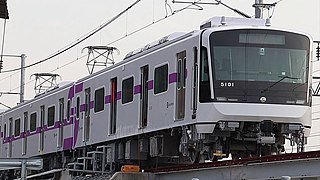
Seoul Subway Line 5 of the Seoul Metropolitan Subway, dubbed the purple line, is a long line crossing from west to the east across the Seoul National Capital Area, South Korea. It is one of two subway lines in Seoul to cross under the Han River, which is done at two points. The main line runs through to Hanam Geomdansan Station while the branch line from Gangdong Station terminates at Macheon Station. In 2019, Line 5 carried an annual ridership of 334 million or about 915,000 passengers per day.

Seoul Metropolitan Rapid Transit Corporation (SMRT) was established in 1994 to operate the Seoul Subway lines 5, 6, 7, 8 in Seoul, South Korea.
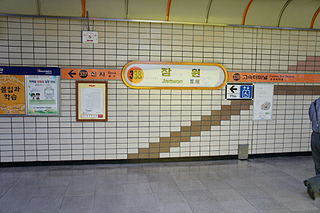
Jamwon Station (Korean: 잠원역) is a station on the Seoul Subway Line 3. It is located in Jamwon-dong, Seocho District, Seoul.

Yangjae Station is a station on the Seoul Subway Line 3 and Shinbundang Line. It was the southern terminus of Line 3 until October 30, 1993, when the line was extended to Suseo station, and it became a transfer station with the Shinbundang Line on October 28, 2011. It is located in Yangjae-dong, Seocho and Gangnam District, Seoul.

Daechi Station (Korean: 대치역) is a station on the Seoul Subway Line 3. It is located in Daechi-dong, Gangnam District, Seoul. It was named after a former village in the area, Hanti (한티), as Daechi is the Chinese reading of the hanja. The name of the station is Chinese characters, meaning "big hill."

Maebong Station is a station on the Seoul Subway Line 3. It is located in Dogok-dong, Gangnam-gu, Seoul and was named after the nearby Maebongsan mountain.
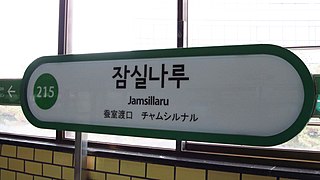
Jamsillaru Station is a station on the Seoul Subway Line 2. Its former name literally means "in the fortress," probably referring to the nearby Mongchon and Pungnap earthen walls, and it was also named from Seongnae-cheon. It is also the closest subway station to the Asan Medical Center.

Dogok Station (Korean: 도곡역) is a station on Seoul Subway Line 3 and the Suin–Bundang Line in Gangnam District, Seoul. This station serves one of the most affluent neighborhoods in Korea; the Samsung Tower Palace complex, which includes one of the tallest buildings in South Korea, has a direct passageway link with the station. Another set of high-wealth residential apartments - the Dongbu Centreville - is also linked by an underground passageway. Other nearby high-wealth apartments include Dogok Rexle complex and Daechi I-Park.

Gangdong District is one of the 25 gu that make up the city of Seoul. Gangdong, literally means "east of river".

Express Bus Terminal Station is a station on Seoul Subway Line 3, Line 7, and Line 9. The stations are located in the Greater Gangnam Area, Banpo-dong, Seocho District, Seoul, Korea.
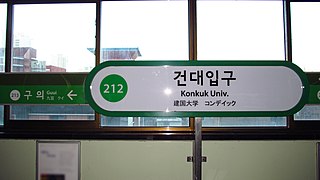
Konkuk University Station is a rapid transit station on Seoul Subway Line 2 and Seoul Subway Line 7. It is located in Hwayang-dong in the Gwangjin-gu administrative district of Seoul. It is adjacent to Konkuk University from which it takes its name. Line 2 is serviced by an elevated platform while Line 7 is serviced by an underground platform. The station has connections to ten bus lines through its six exits as well as a connection to the airport shuttle bus. The station services Hwayang-dong as well as Jayang-dong and Noyu-dong. The area around the station is mixed residential and small commercial businesses. Exits from the underground Line 7 platform open into Konkuk University and the adjacent Star City shopping and high-rise residential tower complex.
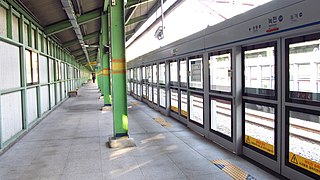
Nokcheon station (Korean: 녹천역) is a metro station on Seoul Subway Line 1 in South Korea. It is located in the northern end of the city.

Gil-dong Station is a subway station on Seoul Subway Line 5 in Gangdong District, Seoul. There is a connecting track from this station to Dunchon-dong Station on the Macheonji Line of Line 5, but it is a return train track for the arrival and departure of the Godeok Vehicle Business Office and has nothing to do with passenger operations.

Gyeongbokgung station (Korean: 경복궁역) is a subway station on Line 3 of the Seoul Metropolitan Subway. It is the subway station nearest to the Gyeongbokgung Palace. The station is also near the Government Complex–Seoul, the National Police Agency of South Korea, and other administrative buildings in the neighborhood.
Sangil-dong is a dong, neighbourhood of Gangdong-gu in Seoul, South Korea.

Seojeongni Station is a station in Seojeong-dong, Pyeongtaek, South Korea. Mugunghwa-ho trains running on the Gyeongbu Line stop here. Additionally, services on Seoul Subway Line 1 have been calling at this station since 2005. Its station subname is Kookje College.

Juan station is a subway station on the Seoul Metropolitan Subway Line 1 and Incheon Subway Line 2. This station receives the second-highest number of crowds along the entire Incheon line due to its proximity to the downtown area. It is also near Inha University and Inha Technical College.

Gubeundari Station is a subway station on Seoul Subway Line 5 in Gangdong District, Seoul.

Namhansanseong station is a railway station on Seoul Subway Line 8.
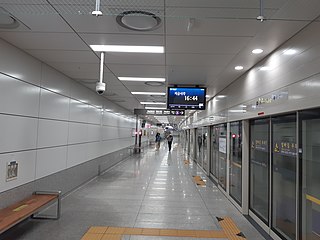
Gangil Station (Korean: 강일역) is a subway station on the Hanam Line of Seoul Subway Line 5, located in Gangdong District, Seoul, South Korea.




















